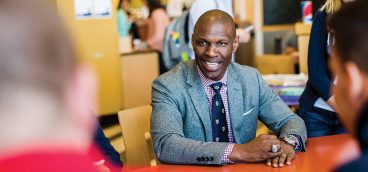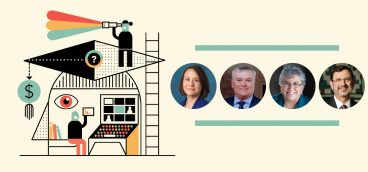High Tech + Higher Ed = ?

Editor’s note: For this special feature, we invited the presidents of the region’s leading colleges and universities to respond to the following:
Technology is presenting unprecedented challenges and opportunities for higher education. While Internet-based learning threatens the existence of some traditional, campus-based institutions, for many others, emerging technology provides opportunities to enhance learning in ways never before conceived. What is your institution’s strategy for adapting and harnessing this new power?
Allegheny College
James H. Mullen Jr.
Allegheny is fortunate that we can follow our faculty’s lead when it comes to making the best use of technology to enhance our students’ experience. Across the disciplines, they have been leaders in exploring technology’s role in the liberal arts and quick to embrace technology: not for technology’s sake but because they know that it can be used to enhance the classroom experience.
To give one example, we’re finding that asking students to blog as part of their class work enhances the classroom experience for both students and teachers. It facilitates the exchange of ideas and continues the conversation outside the classroom—sometimes even after the course has ended. It deepens the discussion and engages the students in an ongoing dialogue that can be remarkably rich and layered—and sometimes provides an even more energized jumping off point when the students and teacher meet for the next class.
Students also can lead these efforts. Last year students in an environmental science course worked with computer science students to develop a mobile app that identifies invertebrates. Allegheny also is working with partner schools in the Great Lakes Colleges Association to explore new and innovative uses of technology as a teaching tool.
California University of Pennsylvania
Geraldine M. Jones
Years ago, we recognized that California University’s career-focused education has tremendous appeal to working professionals—people with full schedules and busy lives. With those folks in mind, we’ve developed 100 percent online degree programs that meet the same high academic standards as programs offered on campus.
For example, we deliver our new MBA: Entrepreneurship online because we understand that if you’re launching a business, you might value the flexibility of online education. The MBA offered through Cal U Global Online is just as rigorous as our face-to-face MBA program, but many students find it more convenient.
The same thinking led to Cal U’s graduate programs in exercise science and nursing administration and leadership. People in those fields rarely have 9-to-5 work schedules, but a master’s degree can help to advance their careers. For them, an online degree program is a perfect fit.
Online education requires a robust delivery mechanism, sound instructional design and professors who can teach effectively in this new environment. Cal U has invested in both the tools and the training—and even our traditional students benefit. Most of our undergraduate and graduate programs now include at least some online courses as an added dimension to on-campus learning.
Carlow University
Suzanne Mellon
Some campus-based institutions may see new technology as a threat to the traditional higher education environment, but what technology really is doing is providing opportunities to reach learners in new and exciting ways.
Carlow University has undertaken a deliberate strategy to expand our Internet course offerings—and, in some cases, degree offerings—to reach undergraduate and graduate students who, for one reason or another, may not be in a position to attend a traditional campus.
We’re also taking steps to enhance the experience for our on-campus learners. Carlow’s new University Commons project involves the complete renovation of the 82,500-square-foot Grace Library Building on the Oakland campus, turning it into the center of campus life and learning. This initiative will provide the related resources and technology required to prepare students with the practical skills demanded in today’s workplace and for careers that don’t yet exist. The University Commons will provide a link between digital and classroom environments as well, and amenities will include computer labs, a state-of-the-art classroom, study spaces and a center to assist faculty in developing online programming.
Chatham University
Esther Barrazone
A study by Babson College and the College Board estimates that approximately 7 million students have taken at least one online distance-learning course in the past year—an increase of 400,000 students from the previous year and a key driver of enrollment growth across the entire sector. Chatham University has adapted to this new marketplace by fully embracing, expanding and enhancing eLearning efforts in both our traditional classroom and fully online programs.
We facilitate learning and innovation in the traditional (and online) classroom through programs such as Chatham Faculty Technology Fellows. This program allows faculty to work intensively with an instructional technologist and other faculty members to integrate technology into their courses in meaningful and innovative ways. This helps ensure Chatham is using technology to enhance the learning experience, test effectiveness and replicate successful programs across the institution.
Chatham also has pursued adapting programs and curriculum to online formats that meet the “speed and convenience” requirements of today’s working adults. For example, Chatham’s doctor of nursing practice is one of the fastest-to-degree programs on the market and the Doctorate of Occupational Therapy program offers experienced clinicians holding only a bachelor’s the opportunity to bridge into our 16-month, part-time doctoral program.
Clarion University of Pennsylvania
Karen M. Whitney
Clarion University was an early and enthusiastic adopter of quality learning via distance education, thus allowing our outstanding faculty to use the best technology in their teaching. We are confident that technology and learning online are not to be feared or ignored, but to be embraced to enrich the learning experience. Faculty members now have more tools available to them as they thoughtfully construct dynamic and inspiring material to engage with students.
Currently, Clarion leads the universities in the Pennsylvania State System of Higher Education in the number of courses offered online. Clarion Online will continue to grow in response to the type of courses and programs desired by our students and the community. View a complete list of what we offer online, including associate, bachelor’s and master’s degrees, as well as certificate and special programs at clarion.edu/online. In fact, one of our newest initiatives and first doctorate program—doctor of nursing practice—is offered online. At the end of the day, it’s about learning and making it possible for our students to succeed by all means possible.
Community College of Allegheny College
Quintin B. Bullock
At CCAC, technology-based learning is an integral part of the educational experience. By incorporating emerging technologies and other advanced learning tools and techniques into the curricula, CCAC faculty are able to simulate real-world situations in order to facilitate creative thinking and solution-driven learning. For example, CCAC makes use of 3-D printing applications in its parametric modeling and mechanical drafting courses. CCAC’s criminal justice program utilizes RUVIS technology, electrostatic dust print lifters, firearms simulators and other technologies to train students in the latest CSI techniques. CCAC also uses a highly sophisticated electronic training system in our mechatronics program, which President Obama recently called “a model for the nation.”
Advanced technology is also readily employed in CCAC’s top-ranked nursing and allied health programs. Our radiologic technology program features state-of-the-art digital instrumentation to train students on the same equipment currently being used in the region’s hospitals. Additionally, students in CCAC’s anatomy and physiology classes regularly use BIOPAC software to plot physiological responses to certain variables including stress and exertion. These are just a few of the many ways CCAC uses existing and emerging technologies to prepare our students to be workforce-ready for careers in an increasingly competitive and global marketplace.
Duquesne University
Charles J. Dougherty
Our strategy at Duquesne for taking advantage of eLearning, now and in the foreseeable future, is two-fold. First, we will protect the special character of our traditional classroom. Duquesne has excelled in this arena for six generations, providing face-to-face support for traditional-age undergraduates on our Pittsburgh campus. There will be online enhancements to this process, perhaps adding online summer classes, but no fundamental changes to the traditional teaching environment on campus. We believe that this is the investment that most of our students and their parents are making in a Duquesne undergraduate education, particularly those who are living on campus or nearby. Outside that context, where our students have a greater ability to learn on their own—among our nontraditional and graduate students—Duquesne will be experimenting with a wide range of eLearning programs and degrees. We already have such degree programs that are leaders in their fields. More will be developed. Given our university’s history and strengths, these programs and degrees will have strong components in ethics and mission-related content. They will also be supported by advisors and online assistance. There is one consideration that could change this calculation over the long haul: If high school education moves more rapidly into online formats, we will be facing a new generation of college freshmen who will not need the personal support taken for granted in the past. They may be ready to move more rapidly into eLearning. If so, then Duquesne will be ready, as well.
Indiana University of Pennsylvania
Michael A. Driscoll
IUP’s use of technology is driven by what is in the best interest of our students. Our faculty use technology to enhance student learning and augment the face-to-face and peer-learning experiences that are the foundation of an excellent education. While IUP uses technology to reach place-committed students and enhance learning, we are careful to apply technology where it makes the most sense.
There is a lot of power in technology, but there are also a lot of cautionary tales. Initiatives like the MOOC (Massive Open Online Course) have brought about a very serious and sober analysis of how technology can and should be used in higher education, and this debate has caused a significant rethinking of the belief by some that technology is, or will become, “the savior” of higher education. Technology is not the end product; it is one of the tools to be used to meet a university’s goal of educating a well-rounded, thoughtful citizenry.
As we educate tomorrow’s leaders, we must prepare our students with a keen understanding of technology and its successful use in their lives and careers, but at the core, we must instill in our graduates an ability to think critically and communicate effectively—with or without the use of technology.
La Roche College
Sister Candace Introcaso
La Roche College’s strategy is to align our mission with the market’s demand for online learning and to accommodate the busy lifestyles of our traditional, adult and transfer students. Our goal is not to become an online school, but to provide online courses and new technology to enhance classroom learning.
We implement state-of-the-art technology to connect students to the world in unique ways. For instance, while student teaching, education majors receive virtual coaching via bug-in-the-ear technology. This mobile technology allows our professors to offer live instruction using Bluetooth headsets, web cams and Skype to improve our students’ field experiences. This connectivity was never available until technology made it possible.
At La Roche, some lectures occur outside of the classroom, meaning professors reserve classes for discussion, experimentation and interaction. Using a unique combination of Internet-based learning and SMART Board lessons, we enable students to understand course material at a deeper level. Our main goal is to stay current, which at a small school means creating a strong infrastructure for acquiring and supporting technology that is both useful and cutting-edge. We continue to seek opportunities for grants and set aside specific revenue for upgrades that support technology, online learning and faculty development.
Point Park University
Paul Hennigan
Point Park is focused on what our students need to survive and to thrive in a professional world increasingly driven by technology. So picking the right technology and understanding the appropriate way to harness its uses is critical not just for our students, but higher education in general. We know technological innovations come fast and furious. We recently had a chance to explore Google Glass on our campus. The technology challenged students to “blue-sky” how an innovation like Glass could change the way we tell people about our school, how we teach and learn, and on the university experience as a whole. Virtual field trips, campus tours, job interviews and outreach to high school communities are just a few of the uses we identified. As educators, our job is to help ensure that kind of innovation isn’t viewed as an end unto itself, but reflects back to what we value as core skills. Innovative thinking, curiosity and excitement for learning don’t require a piece of equipment, but rather a mind and spirit that understands the value of hard work, can think critically, react appropriately and adapt to an ever-changing world.
Robert Morris University
Gregory G. Dell’Omo
Colleges and universities face two major technology-related challenges: 1. How to meet the growing demand—and growing competition—for online degree programs that match the quality of what students learn in traditional classrooms. 2. How to educate students who regard themselves as “digital natives” so that they can apply technology in the workplace to match employers’ needs.
Robert Morris University is meeting the first challenge by providing incentives and professional development to faculty to develop online courses and degree programs, and all new faculty hires need to demonstrate proficiency in teaching online. Employers must know that a job applicant with an online degree from RMU is just as well prepared as someone who took classes on-ground.
Regarding the second challenge, RMU’s new Center for Innovative Teaching and Directed Engaged Learning will support faculty in the effective use of instructional technology, something that also will help meet that first challenge. This center also will develop engaged learning experiences for students tied directly to their program of study, so they can demonstrate to employers what they have achieved with what they have learned. Technical skills are important, but employers tell us that communication, leadership and problem-solving abilities are what they most need.
Saint Vincent College
Brother Norman W. Hipps
Used intentionally and appropriately, technology and interactive media can support learning and development. However, parents and caregivers must be engaged with children in the learning process. These are two of the takeaways from a joint position statement by the National Association for the Education of Young Children and the Fred Rogers Center for Early Learning and Children’s Media at Saint Vincent College.
These findings apply to later learning as well. Digital technologies provide exciting, powerful tools for improving learning, expanding access and increasing efficiency. Pioneers such as Aaron Sams, Salman Khan and Alan Kay use digital tools to provide novel instructional experiences, and our faculty learn from these trailblazers to reimagine their pedagogy. Many use video to “flip” the location and timing of tasks to more effectively utilize face-to-face time, others “chat” or Skype outside regular office hours, and some incorporate virtual experiments otherwise impossible to conduct on campus.
Still, at Saint Vincent, we know that these various technologies are simply tools, and that education is best experienced within a learning community. Learning and creative activity are human endeavors that involve student engagement with faculty who mentor and challenge them, and are expanded by student interaction with faculty and other students.
Seton Hill University
Mary Finger
Seton Hill University has always taken a pioneering approach to education. With that approach in mind, our administration looked to the future of higher education—analyzing research on learning theory, how technology may be rewiring our brains, and the nature of teaching to a generation of students focused on careers—and concluded that incorporating technology into learning would be necessary to the success of our students, and therefore an immediate priority. As a result, our mobile learning program doesn’t just provide devices to students and faculty, it also provides training, through our Center for Innovative Teaching, to ensure that technology deepens the student experience and enhances connectivity beyond our campus. We continue to invest strategically in a premier technology infrastructure that optimizes our students’ access to resources and provides fast, dependable and comprehensive services that assist our students in doing better—better at compiling and organizing data, better at researching, publishing and presenting information, and better at accessing, judging and making decisions. Can emerging technology be a challenge? Of course. It also can be an invaluable tool that opens up the world for the benefit of our students—tomorrow’s leaders.
Slippery Rock University
Cheryl Norton
At Slippery Rock University we’ve taken a very strategic approach to integrating new technology to support and build on our institutional strengths.
We believe a great education begins with great teachers, and so we’ve focused first on making sure our faculty have both the technological tools and the skill sets needed to help students succeed in the world of digital learning. Let’s be honest: the pedagogy for delivering quality online courses is different than teaching face-to-face. Teachers proficient in applying technology to facilitate learning have helped us grow our online courses; which, in turn, has increased access to higher education because students have opportunities for in-time, on-time education using tools with which they are familiar.
Tech-savvy faculty have introduced “flipped classrooms,” where content is online prior to class. This allows actual class time to be used for collaborative, in-depth learning experiences. Technology has allowed us to share teaching resources between and among our sister institutions. Outside the classroom, we’re using technology to help students develop digital portfolios to demonstrate to future employers or graduate or professional schools their competencies. Technology is only a tool to help our students succeed. The heart of the educational experience starts with a quality faculty.
University of Pittsburgh
Patrick Gallagher
The University of Pittsburgh is committed to excellence in education and to using technologies that support our curricular goals and engage students in learning. Our strategy is simple: embrace technologies that will enhance learning, support innovation and encourage experimentation.
New educational technologies are allowing us to enhance student-faculty interactions in newly renovated classrooms that have become active and flexible learning spaces. We have revised teaching practices to use active-learning strategies that allow our students to engage with faculty in the classrooms in ways that were never possible before. New technologies also allow us to deliver more content outside of class and expand the courses available to students on our regional campuses.
Through our teaching and technology centers, we support faculty in developing technology-based innovations in teaching and new approaches to instruction that engage students and enhance student learning. Our Engineering Education Research Center and the Discipline Based Science Education Research Center are engaging faculty in research that includes using technologies in new approaches to teaching, along with bringing those new approaches into the classroom.
Pitt graduates, no matter what their discipline or area of study, will leave the university having been actively engaged with the power of technology to support learning.
Washington & Jefferson College
Tori Haring-Smith
At Washington & Jefferson College, we are using technology within the context of our strong commitment to face-to-face learning in small classes where professors who are dedicated to teaching undergraduates can encourage students to do their best work through challenging courses, supportive advising, and networking with professionals in their field for prestigious internships and research fellowships.
W&J also uses technology to expand our academic offerings. To this end, W&J led the formation of a new 10-college consortium of highly selective liberal arts and sciences colleges that will work to contain costs while increasing access to our institutions. For example, these colleges are looking at video networking as a way of sharing under-enrolled courses. By offering a course at just one campus and allowing other students to participate via video in real time, we can reduce costs while offering an expansive course catalog and maintaining the academic rigor and personal attention for which liberal arts colleges are known. In addition to collaborating with the consortium, W&J employs technology to help students do advanced work so that they have professional publications and conference presentations by the time they graduate.
People are what matter at W&J; we use technology to enhance the human interaction that is the foundation of learning.
Waynesburg University
Douglas Lee
Committed to academic excellence since 1849, Waynesburg University makes every effort to ensure students’ educations will prepare them for lives of purpose for the glory of God.
While the global educational landscape shifts according to technological advances, Waynesburg University continually strives to enrich student learning through the implementation of new technologies.
Our student-centered approach to technology involves considering student expectations and referencing industry best practices. Doing so, we are able to take full advantage of appropriate technologies to provide real-world applications.
Specifically, we are in the process of conducting on-site assessments of our current classroom infrastructure and associated technology deployment plans; strategically incorporating classroom technology maintenance, upgrades and replacements into annual budget planning processes; and exploring new ways for faculty, staff and students to have greater input into the types of technologies made available within the classroom.
Nursing students practice critical patient care on advanced simulators, while criminal justice students develop tactical experience at the university’s training laser shot system. Students in the master of business administration program use computer simulations to bring core business practices to life in a competitive classroom environment.
In all majors and programs, Waynesburg University is working to combine sophisticated technology, traditional classroom education and real-world experience to produce highly skilled graduates.
West Virginia University
E. Gordon Gee
I remain a fierce advocate of the traditional collegiate experience that values interaction between students and faculty, and transports teaching and learning beyond a computer screen. However, technology has revolutionized our lives and the global landscape, and West Virginia University recognizes that.
To that end, we have been strategic in our move into the world of online education—and, in fact, have been involved in it for many years.
One example is the establishment of the first fully online master’s program in integrated marketing communications—even before MOOCs (massive open online courses) came on the scene. It is now one of our most popular graduate programs. Other online courses already in existence, and all highly rated, include nursing, education and business, with the executive MBA program among the top-rated programs in the country.
We also are exploring use of massive open online courses through an agreement with Coursera and this fall will offer two programs: forensic accounting and music industry. In recognition of this growing part of higher education, we have recently revamped and renamed our online unit as Academic Innovation with the charge to merge classroom technologies with instructional design, online programming and media.
Wheeling Jesuit University
The Reverend James Fleming
Today, we have a remarkable opportunity to use technology in ways that will shape our institutions and our world. Emerging technologies exemplify for our students the real worldwide interdependence often called globalization. It is commonplace to “friend” people from the other side of the globe without ever having met them in-person—and to “unfriend” them without the hard work of human encounter—making relationships more superficial than ever. This “globalization of superficiality” as others have called it, challenges us to discover new pedagogies for engaging our students in the depth of thought and imagination that have become hallmarks of American higher education at its best. It is incumbent upon us—with the help of new technologies—to continue to design intellectual experiences of investigation, inquiry and analysis that can offer our students the depth of engagement that transforms them at their deepest core.
Universities will always be used as places where students can prepare for a career path. The present challenge for us is to also ensure that the experience transforms them, so that the graduate upon graduation develops, as Alasdair MacIntyre has written, “a capacity for exercising judgment, for bringing insights and arguments from a variety of disciplines to bear on particular complex issues.”




